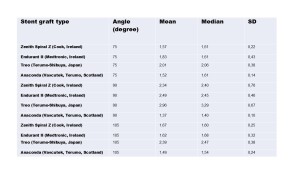Congress:
ECR25
Poster Number:
C-14646
Type:
Poster: EPOS Radiologist (scientific)
Authorblock:
M. Wojtuń1, A. Kazimierczak2, M. Holicki1, M. P. Kawa1, A. Falkowski1, P. Gutowski2, P. Rynio2; 1SZCZECIN/PL, 2Szczecin/PL
Disclosures:
Maciej Wojtuń:
Nothing to disclose
Arkadiusz Kazimierczak:
Nothing to disclose
Mariusz Holicki:
Nothing to disclose
Milosz P. Kawa:
Nothing to disclose
Aleksander Falkowski:
Nothing to disclose
Piotr Gutowski:
Nothing to disclose
Paweł Rynio:
Nothing to disclose
Keywords:
Arteries / Aorta, Interventional vascular, Vascular, CT-Angiography, Ultrasound-Colour Doppler, Ultrasound-Power Doppler, Computer Applications-3D, Experimental investigations, Stents, Aneurysms, Education and training
The whole analysis of the flow velocity ratios obtained from tested 3D-printed models of different iliac artery angulations with implanted stent grafts is presented in Table 1. The smallest increase in flow velocity distally to severe bending was obtained in Anaconda stent grafts group. These results indicate that O-ring-shape stent-grafts have superior flexibility and conformability at various tested angles.

Table 7: Flow velocity ratio analysis for different endograft at various angles. In-stent graft flow velocity ratio was defined as the ratio of the velocity in the part of the stent graft to the velocity measured in the proximal portion of the elastic model. S.D. – standard deviation
Table 1. Flow velocity ratio analysis for different endograft at various angles. In-stent graft flow velocity ratio was defined as the ratio of the velocity in the proximal part of the stent graft to the velocity measured in the proximal portion of the elastic model. S.D. – standard deviation